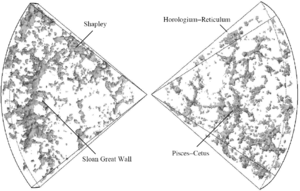From Wikipedia, the free encyclopedia
Not to be confused with the CfA2 Great Wall.
The Sloan Great Wall (SGW) is a cosmic structure formed by a giant wall of galaxies (a galaxy filament). Its discovery was announced from Princeton University on October 20, 2003, by J. Richard Gott III, Mario Jurić, and their colleagues, based on data from the Sloan Digital Sky Survey.[1] The wall measures 1.38 billion light-years (1.30×1025 m) in length, which is approximately 1/60 of the diameter of the observable universe, and it is located approximately one billion light-years from Earth.
Until the discovery of the Hercules–Corona Borealis Great Wallin November 2013,[2][3][4] it was the largest known galaxy filament.
The Sloan Great Wall is 2.74 times longer than the CfA2 Great Wall of galaxies, which was discovered by Margaret Geller and John Huchra of Harvard in 1989.[5] It contains several galactic superclusters, the largest and richest of which is named SCl 126. This is located in the highest density region of the structure. It is followed in size by the supercluster SCl 111.[6][7]
In 2011, it was suggested that the SGW is a chance alignment of three structures, and not a structure in itself.[8]

No comments:
Post a Comment